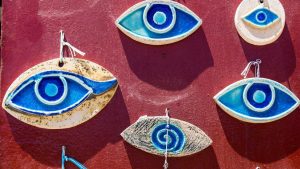What is the evil eye?
The malevolent gaze. You’ve probably seen this well-known symbol before. You’ve almost certainly worn one, and you’ve almost certainly seen someone wearing an evil eye amulet. You may have seen someone deliver the “evil eye” look (and you may have even given it yourself). But do you know the profound history of the bad eye symbol, and how widespread it is in a variety of different cultures? The following is the essential information on the symbol that has become so popular that it is now one of the most fashionable pieces of jewelry.
The Origins and Meaning of the Bad Eye
The evil eye sign and belief is one of the most powerful symbolic pictures in the world. Nonetheless, despite cultural differences, the evil eye myth has roughly the same meaning no matter where it is told. The evil eye is a glance intended to cause pain, suffering, or some type of bad luck to those upon whom it is cast. It’s a look that says you want something awful to happen to the person you’re looking at, either out of jealousy or pure hatred. According to the superstition of the evil eye, the malicious stare is powerful enough to cause actual misfortune for the unfortunate recipient of the glare.
The belief in the bad eye can be traced back to Greek and Roman times. The evil eye was regarded to be the most severe threat to anyone who had been too commended or received more admiration than they merited. The acclaimed person would grow so obsessed with himself or herself that he or she would bring about his or her demise by the bad eye, which was considered to cause bodily and mental illness. The bad eye was thought to be the genesis of any sickness that had no known origin. It was believed that the gods and goddesses punished people who were unduly proud of their achievements by annihilating them with the power of the bad eye, reducing them to the level of common humans.
Every continent has a strong belief in the bad eye. Throughout the Middle East, Asia, Europe, and Central America, the evil eye is dreaded. The prophet Muhammad warns about the dangers of the bad eye in Sahih Muslim Book 26 and recommends taking a bath to counteract its influence.
Excessive praise is supposed to bring about the horrible repercussions of the bad eye, as it was in Classical Greece and Ancient Rome. Rather than admiring a cute child, say that “God has willed” the child’s excellent fortunes, or risk injuring the child. Ashkenazi Jews believe that excessive praise makes them exposed to the bad eye and will shout the Yiddish phrase “Keyn anymore!” which means “no evil eye!” to shield themselves.
The bad eye is a powerful superstition in India. The eye, according to Hinduism, is the most powerful point from which the body may emit energy. As a result, a deep fear of an “evil” glance from the eye makes sense; the bad eye has great power. Hindus believe that even an “adorable” eye might bring bad luck, resulting in a cow milk shortage (again, this idea dates back to the fear of undue praise, first warned against in Greece). Hindus will offer the “admiring” glancer a bowl of milk to ward off the bad eye.
The power of the bad eye, whether wicked or admirable, derives from jealousy, according to the Hindu religion. Surprisingly, Hindus taught that the bad eye is particularly hazardous during life transitions such as puberty, marriage, or childbirth.
Hindus believe that even animals like snakes can have a bad eye. According to Hindu belief, while men can cast the bad eye, women are the most common beneficiaries of it. As a result, females in South India will paint their eyelids black to protect themselves from the bad eye and to avoid staring at others with the look.
Brazil has a belief known as the “fat eye” in South America, which is comparable to the bad eye. Sincere compliments, unlike in other cultures, are not supposed to bring a bad eye, while fraudulent compliments are thought to put one in danger.
In Europe, the notion of the bad eye arose from the belief that jealous or spiteful looks could bring bad luck. Witches were thought to be the most common source of the bad eye. Those with uncommon eye colors, on the other hand, were regarded as formidable possessors of the bad eye look. Germans, for example, feared anyone with red eyes. Squinting eyes were thought to be the work of evil eye sorcerers in Ireland. In Italy, a unibrow was another sign of an evil eye.
The fear of the bad eye was only a metaphor in America. While the superstition is not strong enough to warrant care, the evil eye is considered unpleasant and serves as a warning that the originator of the bad eye has negative intentions.
The bad eye is known differently in different languages.
- The Hebrew word for the evil eye is Ayin Ha’ra.
- The Turkish Evil Eye is Nazar Boncugu.
- Mal Occhio is an Italian term for Evil Eye.
- Bla Band – Farsi.
- Ayin Harsha is an Arabic word.
- Droch Shuil is located in Scotland.
- El Oja in Spanish.
- Mauvais Oeil in France.
- Böser Blick is a German newspaper.
- Oculus Malus.
Methods for Avoiding the Evil Eye
In addition to evil eye amulets, the Greeks carried incense or the cross to shield themselves from the bad eye. Red, black, or white strings, a nail, gunpowder, bread, salt, garlic, a ring, indigo blue, or a pair of silver buckles were all used as protection by new moms. Each of these artifacts had a purpose, making it an effective deterrent to the bad eye. For example, gunpowder represented the capacity to combat the bad eye. The nail represented fortitude. The blue color of the indigo kept its potency. Salt was a sign of endurance and fortitude.
Remedy for the Evil Eye
If these precautions did not work, the Greeks had a plethora of other treatments for the bad eye. To cure the curse, some villages burnt bear fur. In other cases, a gypsy would massage the forehead to remove the bad eye’s effects.
A pinch on the backside is supposed to cure the curse of the bad eye in numerous countries, including Greece, Armenia, and Assyria. Some Christians in Europe make the sign of the cross with their hands while pointing the index and pinky fingers toward the source of the bad eye. To fend off the bad eye curse, a black dot is put on the forehead of children in Bangladesh. To ward off the evil eye, beautiful young women have a kohl dot drawn behind their ears.
Talismans & Amulets Against the Evil Eye
Phrases and rituals are not the only ways to guard against the bad eye’s influence. Many civilizations employ evil eye talismans, evil eye symbols, and evil eye jewelry to avoid the effects of the bad eye. These are supposed to “mirror” the evil look’s power. The bad eye amulet was invented in Greece as an “apotropaic” amulet, which meant that it reflected damage. The most basic design of the bad eye, known as the Nazar, is a talisman with concentric blue and white circles to signify the bad eye. It’s frequently seen on houses, vehicles, and jewelry.
Evil Gaze
The Hamsa, often known as the “Hand of Fatima,” is one of the most potent examples of an evil eye amulet in the Middle East and Africa. The hamsa is a sign of a hand with an evil eye on the palm. To ward off the bad eye, the hamsa can be utilized as wallpaper or jewelry. The hamsa is also known as the “Hand of God” or “Hand of Miriam” in Jewish culture. The hamsa’s appeal in jewelry and design has been influenced by the popularity of Kabbalah.
Modern-Day Evil Eye
Even in modern life, pop culture, and even jewelry and design, the bad eye has a strong influence. Who hasn’t heard the phrase “the evil eye” or had it thrown on them at least once or twice? The bad eye is engrained in Turkish culture and has deep symbolism. The bad eye pendant is worn on items that are said to attract avarice, envy, or ill intent. In Turkey, the bad eye sign can be found on coinage, in homes and businesses, around the necks of newborn children and farm animals, and in building foundations.
Jewelry with the Evil Eye
The bad eye is a trendy piece of jewelry right now. Many celebrities, including Madonna, Britney Spears, The Olsen Twins, Mick Jagger, and Nicole Richie (to mention a few), have been pictured wearing red Kabbalah wristbands, which are supposed to be another way of protection from the bad eye. Cameron Diaz, Kelly Ripa, Brad Pitt, Kim Kardashian, Lindsay Lohan, Lauren Conrad, and Rhianna have all worn the bad eye amulet in public. This famous and attractive image has grown in popularity.
Is the Evil Eye Just a Legend?
Surprisingly, the notion of the bad eye appears to make a lot of sense in our modern environment. The belief that too much fame, riches, success, or praise might lead to one’s demise, particularly in celebrity culture, may perpetuate the notion of the evil eye. Ms. Lohan and, more recently, Charlie Sheen are both illustrations of how the power of success can turn into calamity. Could Lindsay be in better shape if she’d started wearing the bad eye sooner? Millions of believers would almost certainly agree. In any event, those who are frequently in the spotlight, such as celebrities, or those who have achieved success or have reason to be proud, should probably carry an evil eye amulet or evil eye talisman with them – just to be safe!



